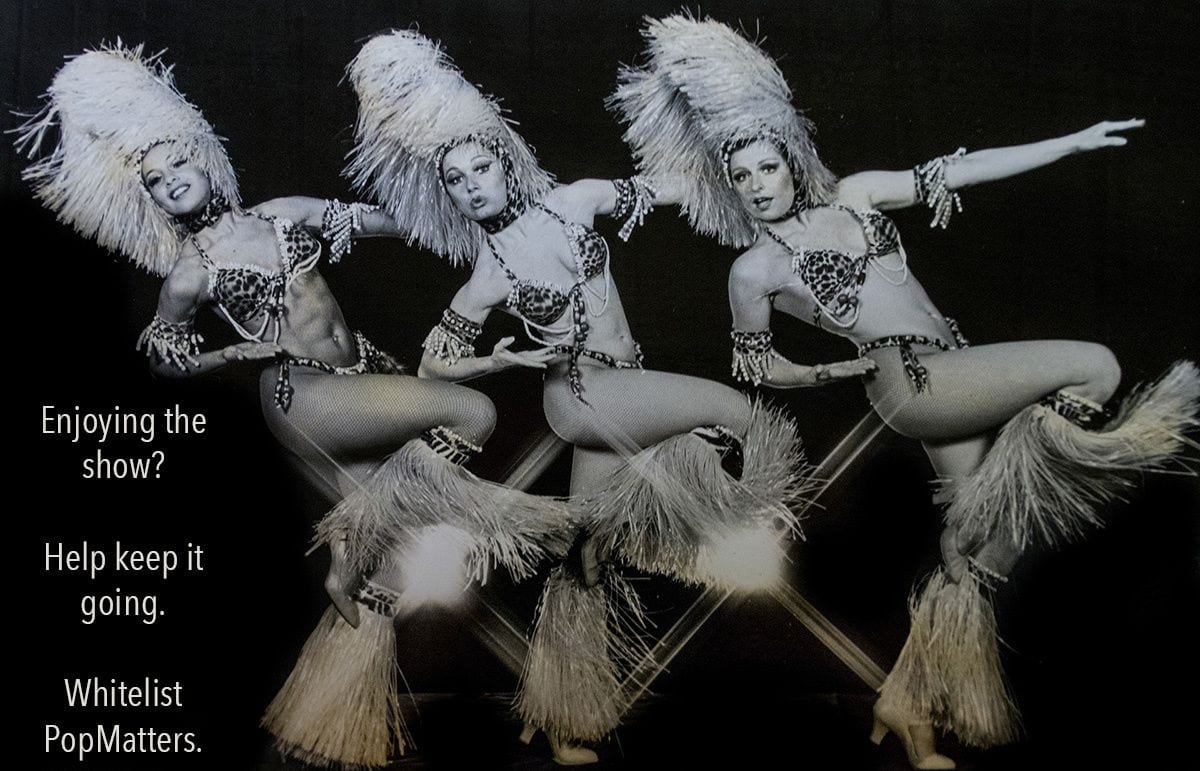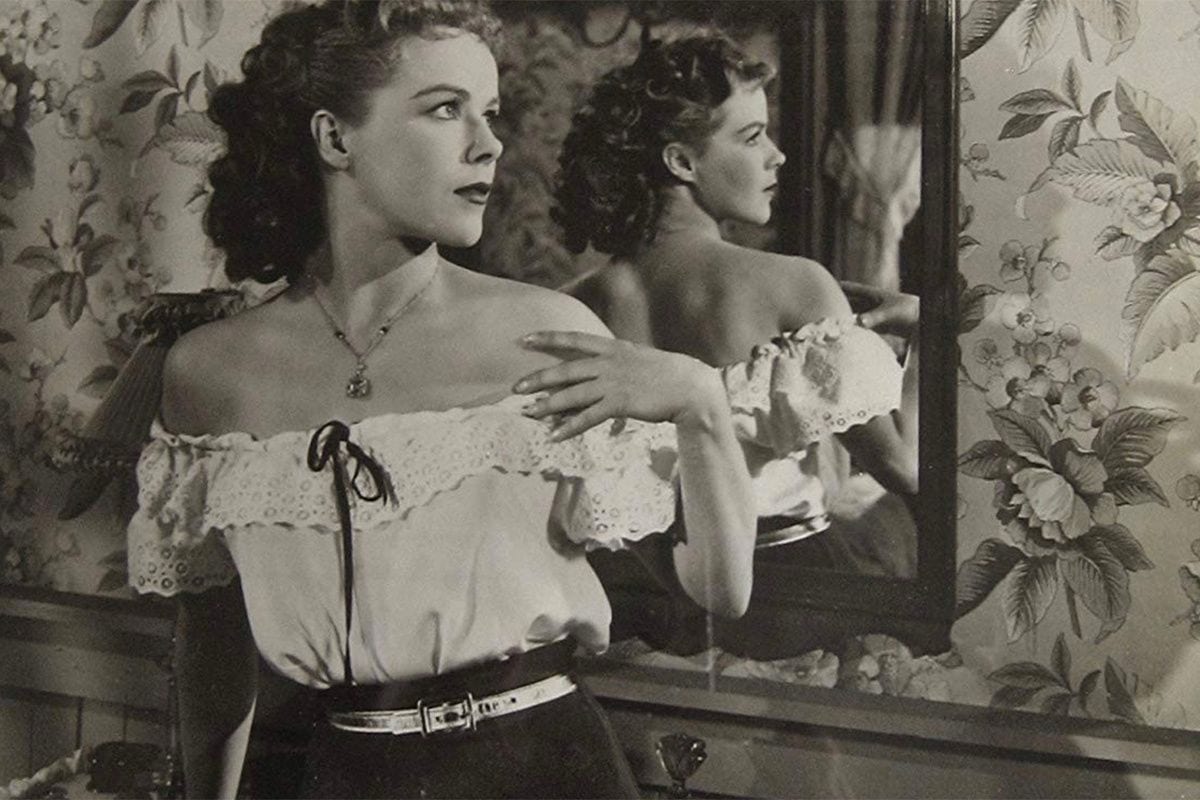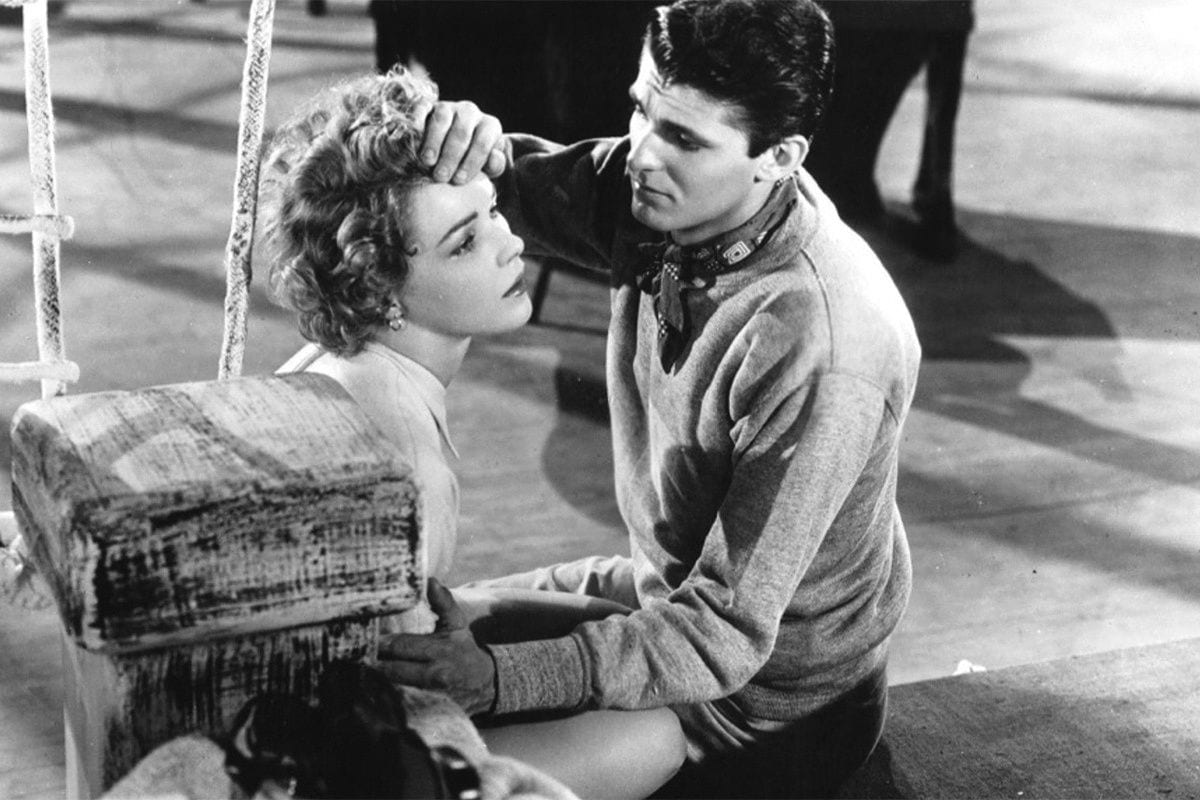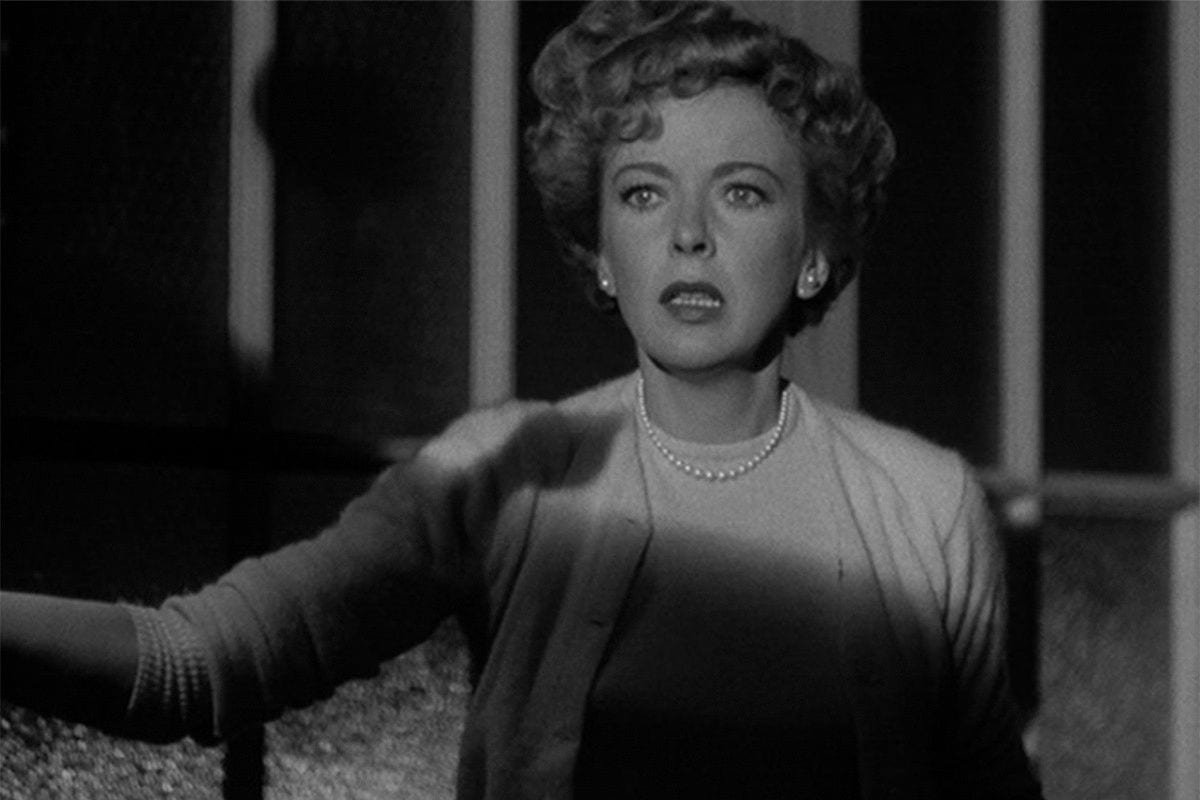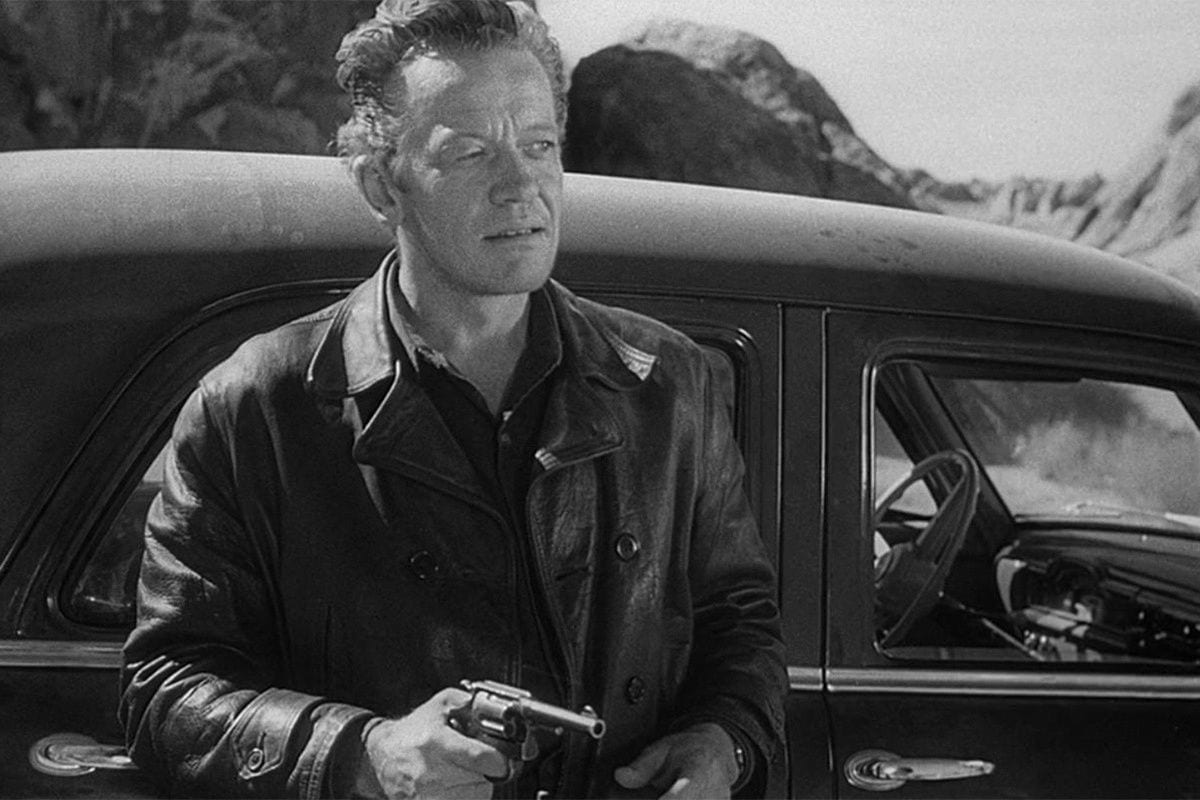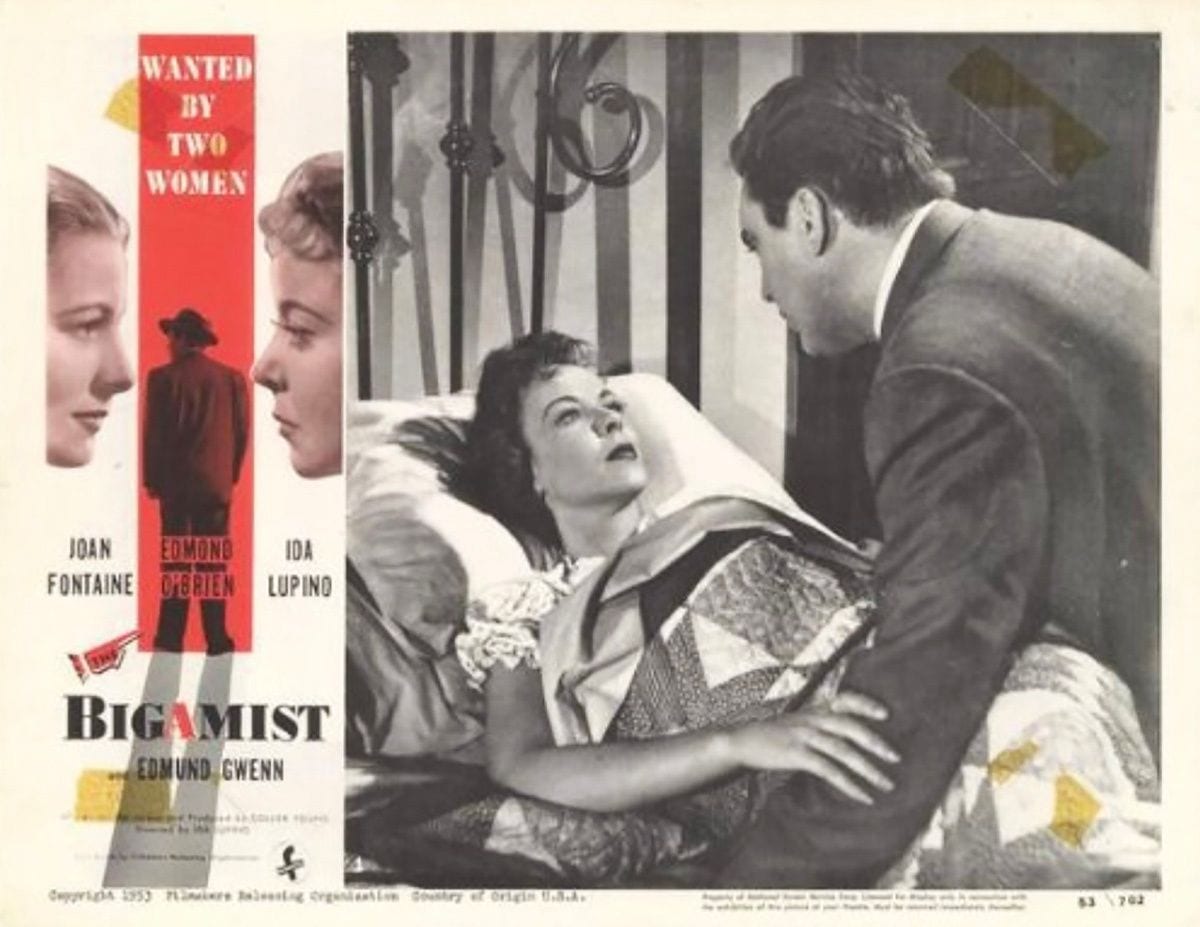

The four restored films in Kino Lorber’s Blu-ray box. Ida Lupino: Filmmaker Collection, give viewers a fresh opportunity to consider the career of Ida Lupino, the only woman directing Hollywood features in the 1950s.
Having grown up in a famous English theatrical family with Italian roots, Lupino acted since childhood and worked in films from her teen years. She’s best known for her versatility in the postwar noir genre, which showcased her variations on tough women with a vulnerable streak. For a demonstration of her range, sit down for a binge with Raoul Walsh’s
They Drive By Night (1940) and High Sierra (1941), Charles Vidor’s Ladies in Retirement (1941), Jean Negulesco’s Deep Valley (1947) and Road House (1948), and Nicholas Ray’s On Dangerous Ground (1951), and you will believe.
Deep Valley was the end of a fraught Warner Brothers contract during which, while joking that she was “the poor man’s Bette Davis”, she also followed Davis’ tendency to disrupt the system and get suspended for complaining about her roles. Lupino stated that this period developed her interest in what the director was doing.
When she married producer-writer Collier Young in 1948, they formed their own production company, which settled on the name The Filmakers (with one “M”). In this way, Lupino belonged to a contemporary trend of certain stars, such as John Garfield, Burt Lancaster, Kirk Douglas and John Wayne, taking greater control of their careers via their own companies. It’s significant that Lupino was the only female star in this trend while bigger contemporaries like Bette Davis and Joan Crawford didn’t do so and found their careers drifting. The Filmakers would release a dozen films through 1955, six of them directed by Lupino. Four of them are in this box set.
Dancers by hsvbooth (Pixabay License / Pixabay)
Not Wanted (1949)
In Not Wanted, the subject is unwed motherhood, a controversial topic that attracted publicity.
Lupino co-wrote and co-produced the company’s debut,
Not Wanted, while leaving the director’s credit to Elmer Clifton, whom she replaced after he suffered a heart attack. This force majeure marked her debut in the director’s chair, where it turns out she felt comfortable, calling herself “Mother” on set to encourage everyone to think of her as a feminine, maternal sort of boss — but still the boss. The opening credits, which are presented in an unusual upward scroll over the image of its heroine slowly approaching the camera uphill, identify Lupino as “presenting” the movie.
The subject is unwed motherhood, a controversial topic that attracted publicity. Wikipedia quotes Mary Hurd’s
Woman Directors & Their Films (Praeger, 2007) in stating that Lupino got to discuss the film on the radio with Eleanor Roosevelt. As Lupino explained in various interviews, The Filmakers specialized in “headline” social topics generally avoided by the mainstream studios. They were “problem films” that tried to entertain while throwing some light on some issue, and several of the issues concerned women. Outrage (1950), not included in this set, concerns rape without mentioning that word; “rage” becomes a kind of visual-lexical code for it.
This strategy is commercial as well as social, and it links Lupino’s
modus operandi with that of Lois Weber, who became the highest-paid film director of the 1910s with a string of films that courted controversy. For example, Weber’s Where Are My Children? (1916) raises the topic of illegal abortions (as all abortions were illegal in 1916) by condemning selfish upper-class woman who have them.
The tendency to frame radical topics within conservative formulae and solutions, thus perhaps annoying everyone, can be seen to a minor extent in Lupino’s films, as in all indie “exploitation” dramas that pushed the edge of “offensive” topics by adopting a moralistic and reassuring stance. However, nothing in
Not Wanted takes a gloating or satisfied tone towards the suffering of its heroine, who is solidly our identification figure. To show how this material can be handled more exploitively, the Blu-ray throws in a startling bonus short, The Wrong Rut, which recycles footage from Not Wanted and throws in a sex lecture and actual footage of giving birth, including a Caesarean procedure.
Even within their negotiation for acceptability, Lupino’s movies can be read ambiguously and certainly sympathetically. Several critics have picked up on her stated preference for “weak” characters, both male and female, over the strong characters typically presented in films. In other words, she focuses on characters who have lost their way and don’t know what they’re doing or where they’re going. Thus she connects with the average viewers’ sympathies not through wish-fulfillment figures but with people who flounder like we do and become frightened by what happens, even as the results of their own decisions.
Not Wanted opens with Sally Kelton (Sally Forrest) trudging towards the camera like a lost soul or a sleepwalker, an impression reinforced when, as she finally comes into close-up and becomes spellbound by a baby in a carriage on the sidewalk, she picks up the child and begins to carry it away before the frantic mother chases after her. In a daze, Sally insists it’s her baby.
She’s booked at the police station and escorted into a cell with female floozies, crazies, and lesbians, a setting ripe for its own one-act play that never arrives. The long flashback begins with Sally, whose mother (Dorothy Adams) is depicted as an angry nagger in the kitchen who doesn’t want Sally to replicate her own choices, falling for Steve Ryan (future TV director Leo Penn), a squirrelly boogie-woogie pianist with classical aspirations. Liking the dreamy way he tickles the ivories, Sally follows him around with goo-goo eyes and allows nature to take its course in a symbolic scene where the camera glides away to follow his cigarette butt floating downstream, a male object polluting something pure and natural.
The scales fall from her eyes when she impulsively follows him from her small burg to “Capital City”, by which time she’ll learn she’s knocked up as she gets hired and befriended by aw-shucks corn-fed Drew (Keefe Brasselle), who manages a gas station and would like to know her better. He throws in a little joke about how she’d better not offend the boss, ha ha. Not to get too Freudian, he’s also damaged goods thanks to limping on a plastic leg from war injury.
Sally Forrest as Sally Kelton in Not Wanted (IMDB)
The script by Lupino and future blacklisted writer Paul Jarrico, from a story by Jarrico and Malvin Wald, finds depth in everyone. Steve isn’t a mustache-twirling Lothario or even a slick operator but a sweaty, neurotic, self-loathing type who’s “tired of his life” and thinks there’s something wrong with him, or several things. He claims he never lied to Sally about their prospects; his rationalizations are ambiguous but not completely false. Drew, though manifestly a “good guy” for contrast, also says and does things that don’t always put him in a good light. All characters are intelligent and reasonable. Also in the cast are Ida’s sister Rita Lupino and yet another future TV director, Lawrence Dobkin.
This Academy Film Archive 4K restoration makes clear how well-directed the film is. The actors are handled with intelligence, the pace is sure, and visual choices underline psychology. A shot with Sally and Drew on a truck bed uses highly reflective windows looming diagonally over them as they seem hunched under the weight of the open world. This shows the art direction of Charles D. Hall, a celebrated master from Universal Pictures nearing the end of his career, and so does the womb-like scene of Sally and Drew playing with his huge train set and turning lights on and off. Here they tower over their environment, for a change, as they do the looming.
These scenes also show off the photography of Henry Freulich, as does the masterful subjective scene of Sally going into the delivery room, with its interplay of expressionism, alternating focus, handheld wooziness and fuzzy music. It’s one of several moments when Sally’s subjectivity is conveyed with an out-of-tune piano (reminder of Steve) playing a sort of Dies Irae.
Another subjective moment, signaling her unrealized pregnancy, takes place at a carousel and uses modernist flash-cutting by William Ziegler, one of classic Hollywood’s most versatile and illustrious editors. He was a couple of years away from cutting the merry-go-round sequences in Alfred Hitchcock’s Strangers on a Train (1951), so this feels like a preview.
Never Fear (1949)
Never Fear seems to have been the first serious feature to focus on polio.
Forrest and Brasselle are together again in the same year’s
Never Fear, Lupino’s officially credited directorial debut. Carol (Forrest) and Guy (Brasselle) are a struggling pair of nightclub dancers who plan to marry as soon as their act acquires legs for the big time. Suddenly, in rehearsal, Carol begins having the same kind of subjective distortions as Sally in their previous movie, only for a different reason. She’s diagnosed with polio.
The rest of the film concentrates on her painful recovery, both physically and emotionally, on location in Santa Monica’s Kabat-Kaiser Institute complete with actual polio patients as themselves. Her bitter, despairing thoughts are part of the problem, and she’s inspired by a rather overbearing and indefatigably perfect fellow patient (Hugh O’Brian’s film debut). Lawrence Dobkin and Rita Lupino, both seen in
Not Wanted, appear again.
Although polio had previously been a melodramatic plot device, always striking the hero or heroine’s child and usually with a tearful last-reel recovery,
Never Fear seems to have been the first serious feature to focus on the disease as its theme. The American Film Institute’s subject index for poliomyelitis indicates a Monogram picture of a few years earlier, William Nigh’s Forever Yours (1945), in which the heroine must overcome polio with a radical new treatment, but that had no medical basis.
By contrast, this script by Lupino and Young is both realistic and highly personal, for the disease struck Lupino in 1934. She escaped the most crippling effects, and Carol is essentially inspired by herself. That’s why the film’s opening states that the story is based on true events and was filmed where they happened, meaning the institute that gives the film its docudrama quality.
The credible ending doesn’t show plucky Carol dancing out of treatment, for she’s on crutches and still on the path to recovery. Throughout, the central problem isn’t so much the disease or treatment but Carol’s decided non-pluckiness before she finally castigates her “self-pity”.
This film was made several years before Dr. Jonas Salk’s vaccine revolutionized what was one of the most terrifying and devastating diseases in the world. The film’s topicality is obvious, but the subject was so unsettling that it hardly promised box office success, and that didn’t arrive. The American Film Institute Catalogue reports that the film’s title was changed in some venues to The Young Lovers, apparently an attempt to sound more commercial.
Once again, the craftsmen are tops. Photographer Archie Stout, primarily associated with John Ford, provides crisp realism with moments of glamour (especially dance routines) or subjective expression, all looking good in this British Film Institute 2K restoration. Leith Stevens scores the film, as he did for all the films in the box. The production designer is Van Nest Polglase, titan of RKO’s art department, whose six Oscar nods include Orson Welles’ Citizen Kane (1942). Ziegler again does the editing, here co-credited with Harvey Manger.
We’ve mentioned that Lupino’s next film, Outrage (1950), isn’t in the box set, and neither is the one after that, Hard, Fast and Beautiful (1951, available from Warner Archive). Forrest returns in the latter as a conflicted tennis star who feels pushed by a “stage mother”. The heroine’s success isn’t necessarily seen as a good thing, since she doesn’t truly wish for it out of her own agency–just as Lupino felt pushed into acting because her family expected it of her. It’s the kind of move that doesn’t always sit well with some feminist critics, who yearn for strong role models having it all, and that’s not Lupino’s beat.
Sally Forrest as Carol Williams and Keefe Brasselle as Guy Richards in Never Fear (IMDB)
Ronnie Scheib’s excellent 1973 appreciation of Lupino, an early critical defense of her output, is reprinted in the set’s booklet. She begins by referring to Andrew Sarris’ dismissive assessment in The American Cinema (E.P. Dutton, 1968) that Lupino’s films “express much of the feeling if little of the skill that she has projected so admirably as an actress” and goes on to note that “Lupino fares little better with feminist critics who are more concerned with statement-making than with filmmaking.”
Scheib calls the tennis picture “a pivotal film in Lupino’s work, mid-point between the more subjectively charged, single-focus early films and the colder, more detached, multiple-viewpoint late films. As her films move away from subjectivity, they also move away from women and adolescence, although never from passivity and its curious coloration, its dream-walking eternal present. But passivity in a young girl and in a middle-aged man are two very different states. In Edmond O’Brien, the perpetually pressured everyman of the Fifties, Lupino found the perfect embodiment of another kind of passivity: a helpless entrapment between two modes of life, of action.”
O’Brien most famously embodied a sweaty, frantic, helpless entrapment in Rudolph Maté’s noir classic D.O.A. (1949), in which his character is essentially dead before the film begins, and his long flashback merely recounts the story of his own murder. Lupino would direct him in two 1953 films, including another noir classic that’s her own most famous picture and the one inducted into the National Film Registry.
But hold that thought, for we interrupt this survey of the box set in order to bring you a separate Blu-ray released by Kino Lorber. Michael Gordon’s Woman in Hiding is an example of the work Lupino did as an actress for hire, and which allowed her to finance her own films. It’s also the movie where she first acted with Howard Duff, who’d become her third husband, and thereby hangs a Hollywood soap opera.
Woman in Hiding (1949)
Woman in Hiding joins a long line of women-in-peril films that trade in paranoia based on women’s patronized, second-class legal status in a society that’s ready to write them off as hysterical or crazy.
This Universal production begins in frantic fascination as we see Lupino’s character speeding recklessly to plunge her car off a bridge. The next day, a crowd of people populate the scene as the river is dragged, complete with cannon fire. Lupino’s echo-chamber narration announces “That’s my body they’re looking for” and finally identifies herself, Deborah Chandler Clark. Is she a ghost, like William Holden’s narrator in Billy Wilder’s
Sunset Boulevard (1950)? After husband Seldon Clark (Stephen McNally) deflects questions on why his wife ran away on their wedding night, her voice chimes in again, as though she’s overheard everything. “When was it that murder first entered your mind?”
This vivid, spooky, disorienting opening leads to Deborah’s ten-minute flashback in which we learn that her rich mill-owning father dislikes Seldon, that Deborah has carried a torch for the guy, and that he practically strong-arms her into a wedding after her daddy’s suspicious death. He wants the funeral meats to coldly furnish forth the marriage table.
On their honeymoon in a mountain cabin, they’re greeted by his drunken, pistol-wielding ex-girlfriend (Peggy Dow), leading to revelations that cause Deborah’s midnight flight that opened the movie. Now we know that Seldon tampered with the brakes and that Deborah jumped from the car before the crash.
Now comes the part we must swallow with several grains of salt in order for the story to continue. The next morning, Deborah resists her impulse to tell everyone she’s alive because she’s afraid nobody will believe her story unless she can secretly find the girlfriend. It doesn’t occur to her that she doesn’t need a story; she only needs to tell her attorney that she wants the annulment she’d planned to get last night and then stay away from Seldon until it’s done. However, that would be entirely too reasonable. We must believe that, in her panic, she’s not thinking straight and so runs away on an odyssey of changing her name and hair while her husband advertises a reward for her discovery.
The film joins a long line of women-in-peril films that trade in paranoia based on women’s patronized, second-class legal status in a society that’s ready to write them off as hysterical or crazy. Because this undercurrent has a basis in reality, we get pulled along on a superficially far-fetched story that relies on coincidence and contrivance. If we step back, we might see the artifice, but usually we just enjoy being wrapped up in it. An actress like Lupino makes it possible to distract us from the less credible aspects of the story, and so do professionals like photographer William H. Daniels, who lavishes the compositions with reflections, sinister shadows, and one hellacious hotel stairwell.
The most important aspect of this movie, however, is the story behind the scenes, for this is the movie where Lupino met Howard Duff. He plays carefree ex-soldier Keith, who becomes interested in the nervous heroine, especially when he figures out there’s a reward for her as the return of her husband’s rightful property. The tension between his seemingly open and friendly interest and his secret analysis is among the plot’s most distressing elements, since even he’s not willing to trust her story. For Deborah, this is a slippery, dangerous world, and this confirmation can feed into her impulse to flee instead of behaving more sensibly.
Although Lupino contributes to this film only as an actor, it’s intriguing that Deborah and Keith start building their friendship on a bus in this highly vehicular movie, just as Sally and Drew met on a bus in Not Wanted and Phyllis will meet Harry on a bus in The Bigamist. It says something about Lupino’s persona and worldview, as well as midcentury American culture, that her characters are always taking the bus.
You might think The Filmakers would be jeopardized by the fact that Lupino, already pregnant with Howard Duff’s daughter, divorced Young in 1951 to marry Duff. On the other hand, Young promptly married Joan Fontaine the next year, and she’d star in Lupino and Young’s The Bigamist. That’s the movie where the husband is torn between Lupino and Fontaine — ouch!
The Filmakers didn’t dissolve until financial issues in 1955, and when Young moved into TV, he continued to provide work for his ex-wife. For example, he created and produced Mr. Adams and Eve (1957-58), a sitcom starring Lupino and Duff! It’s good to know they were all so friendly.
That brings us back to the last two items in the Lupino box, her Edmond O’Brien films, The Hitch-Hiker and The Bigamist.
Ida Lupino as Deborah Chandler Clark in Woman in Hiding (IMDB)
The Hitch-Hiker (1953)
The Hitch-Hiker isn’t a film about Mexican grotesques and stereotypes, but about the psychological desert within the mainstream Americans and their tormentor.
Drafted into the National Film Registry, The Hitch-Hiker is an especially cruel and frustrating suspenser defined entirely by men’s inability to act effectively. Our heroes spend the movie helpless, their masculinity undermined in a desolate landscape where all that matters is who’s got the gun. This is another film, like Edgar Ulmer’s Detour (1945) and Felix E. Feist’s The Devil Thumbs a Ride (1947), that stokes paranoia about hitch-hikers. The dialogue by Young and Lupino (now divorced but still collaborating) quotes the latter film with the line “the devil thumbed a ride”.
As with Lupino’s earlier films in the set, this one opens with the statement of being based on real events. The meat of the drama comes from the spree of one Billy Cook who, after committing several murders as a hitchhiker, forced two hunters to drive him to Santa Rosalia, Mexico, and who did, just like the criminal in the film, have one bad eye. Lupino interviewed all three players in the real-life drama, including Cook prior to his 1952 execution. These events would still have been in the public’s mind.
The taunting, sadistic psychopath Myers is played excellently by William Talman, best known as hapless D.A. Hamilton Burger on the Perry Mason TV series. As Scheib observes, Myers functions at gunpoint as a “director” for the other two men, and a far less benign one than the director figures played by Brasselle in Lupino’s first two movies.
Myers’ malign presence creates the helpless passivity of Roy (O’Brien) and Gilbert (Frank Lovejoy), who begin the film already morally and spiritually lost. They’re allegedly on a fishing trip in Arizona, as they’ve told their wives, and this is their first time away from their families since the war. Their desultory lines and postures, in which they discuss turning back, make it clear that their weekend has just started and they’re already not having fun and seemingly don’t expect any. They’re not suffering from PTSD but from its opposite — malaise.
Obviously old friends, Roy tries to convince a dubious Gilbert that they might have fun in Mexico trying to recapture old memories. He drives to Mexicali, where a hawker tries to lure them into a joint to witness “Juanita’s famous fan-dance”, but Gilbert pretends to be asleep, so Roy drives on. We’re left to surmise that their discomfort with each other might be from the fact that their lives and interests have diverged since the old days, and maybe this trip was a doomed attempt to catch the old camaraderie. The irony is that if they’d stayed for the fan dance, they wouldn’t have met their shadowy nemesis, who teases and berates them for lying to their wives while sneaking off to Mexico.
Their Mexican impulse has led them dangerously astray, as once again, Mexico psychologically represents America’s fantasies and terrors in a noir film. It should be noted that the many Mexicans we see are sensible, credible figures who speak to each other in untranslated Spanish, and that the Mexican police are depicted as efficient and competent — which also mirrors the real-life incident. This isn’t a film about Mexican grotesques and stereotypes but about the psychological desert within the mainstream Americans and their tormentor.
William Talman as Emmett Myers in The Hitch-Hiker (IMDB)
The landscapes (not shot in Mexico, of course, but California) dominate the film along with the shadowy night photography of RKO’s Nicholas Musuraca, who’s as responsible as anyone for the vogue in noir expressionist chiaroscuro. This 2K Library of Congress restoration allows us to appreciate his dazzling work because, while the print isn’t perfect — there are vertical scratches throughout — the results are more crystalline than this public-domain item has looked in many a moon.
Scheib notes the class element of how white-collar Gilbert is judged “the smarter one” and the one who reasons out the chances of handling Myers, while Roy is paralyzed with fear and rage over his impotence. The plot is a series of missed chances and tense disappointments in which the friends witness each other’s humiliation and can only support each other while bickering.
Even the ending hardly provides the clichéd catharsis that we’ve been trained to expect and desire from such scenarios. The men are rescued by the police, and Roy tries to get some of his own back by beating a man who now can’t defend himself. Gilbert must calm him down by saying “it’s all right”, but we feel it probably really isn’t.
This film can be especially frustrating if you expect movie heroes who resourcefully get out of situations with their brains and fists. The scenario calmly subverts that. There’s plenty of queasy action and danger, but this film is existential, not wish-fulfilling. Thus, the thriller conventions render stark what had been submerged in Lupino’s other films: the heroes and heroines never act heroically. In concentrating on headline stories and social issues that studios avoided, The Filmakers presented sympathetic analysis of human specimens also avoided in other movies. It takes a marathon of Lupino’s films to make this obvious.
The Bigamist (1953)
The Bigamist asks who, better than a woman on an unconventional path, can analyze the traps of standard gender roles and expectations?
As a study of the postwar middle-class American male,
The Hitch-Hiker is no rosier than The Bigamist. The latter film opens with Harry and Eve Graham (O’Brien and Fontaine) hoping to adopt a child from agent Mr. Jordan (Edmund Gwenn), whom Eve describes as looking like Santa Claus. That’s an inside joke, since Gwenn had starred in George Seaton’s Miracle on 34th Street (1947). And just in case nobody got it, both Gwenn and the movie are name-checked in the sequence about Hollywood stars’ homes, and several other stars are also mentioned. We might have expected them to drop Lupino’s name, but that would have been going too far.
The Grahams jointly own a business they started four years earlier (not unlike Lupino and Young). It’s the “deep freeze” business, with Harry the traveling salesman (he refers to the jokes and his own failure to live up to them) while Eve, whom he brought into the office to distract her from her inability to have children, has turned out to be the better businessman and increased their sales. In her “executive moods”, her success renders him forlorn and emasculated because she’s frankly better at the job and he recognizes it, so that he feels more her drudge than her hero.
When he makes gentle overtures, she’s the one who turns aside and goes to sleep. Is Eve or Harry the “deep frozen” one, or is it both? If it feels unusual for a woman-directed movie, in the 1950s or anytime, to be sympathetic to the plight of the nominally privileged male, we may ask who better than a woman on an unconventional path can analyze the traps of standard gender roles and expectations upon even the ones who supposedly benefit?
The first 20 minutes follow Mr. Jordan’s investigation until he uncovers the title’s whopper: when not in San Francisco, Harry lives in Los Angeles with a second wife, Phyllis (Lupino), a bruised working-class woman very different from the cool patrician (or matrician?) Eve. Phyllis seems better suited to Harry, and that’s one of the film’s carefully balanced points.
One index of the women can be found in the parallel “gift” scenes. Phyllis gives Harry cologne and rubs it on him while he closes his eyes in bliss, reporting that “it’s working” to cure his headache. After her father’s death, Eve passes on to Harry her grandfather’s heirloom watch, a heavy chain affair that represents tradition, time and work. In short, Phyllis makes Harry feel like a desirable man and Eve weighs him down and makes him feel old.
What’s surprising about Young’s script is how sympathetic and non-judgmental it is towards Harry, the criminal who’s clearly to blame for creating his situation. When he tries to tell Eve about meeting Phyllis, she doesn’t take it seriously and turns it aside. When he asks Phyllis why she doesn’t want to know if he has a wife and kids, she says it wouldn’t help her to know such things.
He’s led step by step into a muddle less by selfishness than by consideration. He wants to give each woman something she wants and to avoid hurting her, especially when unmarried pregnancy enters the picture as in Not Wanted. In echo of Not Wanted, there’s a shot of Harry trudging uphill.
Just as the husbands in The Hitch-Hiker summon their torment by avoiding fan-dancers and by being good Samaritans, in other words by doing the right things, Harry the bigamist is too big-hearted and sensitive under his “big lug” exterior. Viewers expecting rage at masculine entitlement will be stymied to discover a man defined by loneliness, stasis and the frustrating passivity about where his choices lead him that marks Lupino’s other films.
Her world is the one where bad things keep happening to good people and where social acceptability is the narrow trap. Lupino called her characters “bewildered”. For a woman who projected such a strong persona and did so many unusual things, she must have often felt bewildered.
Let’s think about it. It’s typical for Hollywood to trade in conservative verities while exploiting some titillating situation, to punish and condemn sexual transgressors, to show they got what’s coming to them by coloring outside the lines. And yet, here’s a movie directed by a woman who divorced the producer-writer because she became pregnant with another man’s child and who married that other man, while the producer-writer married the other actress in this film, and none of this prevented them from working together.
If that’s their experience of life, wouldn’t it be hypocritical to start wagging conventional fingers about adultery and pregnancy? In this context, the scene where Harry meets Phyllis on a tour of the movie stars’ homes makes sense as a comment on the difference between private lives and public faces, and between Hollywood movies and reality.
Ida Lupino as Phyllis Martin and Edmond O’Brien as Mr. Jordan in The Bigamist (IMDB)
Kino’s 4K restoration shows off the location photography of great noir cinematographer George E. Diskant. His recent work included two milestones of Nicholas Ray, They Live By Night (1949) and On Dangerous Ground (1952), the latter starring Lupino, and there are rumors that she directed parts of it. In 1952, he also shot Lupino in Harry Horner’s Beware My Lovely for The Fillmmakers. She must have been very comfortable with him, as she used him for her starring episodes in Four Star Playhouse (1952-56), a TV anthology from the next company she co-founded, and he also worked on Mr. Adams and Eve.
Each Blu-ray comes with a critical/historical commentary track: by Barbara Scharres and Greg Ford on Not Wanted, Alexandra Heller-Nicholas on Never Fear, Imogen Sara Smith on The Hitch-Hiker, and Kat Ellinger on The Bigamist and Woman in Hiding.
After the mid-’50s, Lupino appeared in only a handful of features and directed her biggest hit, the schoolgirl comedy The Trouble with Angels (1966). Otherwise, she devoted her energy to TV. Besides acting in many series from Batman to Columbo, she directed on high-profile shows such as Alfred Hitchcock Presents, The Twilight Zone, 77 Sunset Strip, Have Gun Will Travel, General Electric Theatre, Thriller, The Untouchables, The Fugitive, Kraft Suspense Theatre, Dr. Kildare, Bewitched, Gilligan’s Island and The Ghost and Mrs. Muir. She even directed Edmund O’Brien again in his engaging 1962-63 series Sam Benedict (available from Warner Archive), in which he plays a loud bulldozing lawyer, and she guested on one episode as his ex-flame.
A full accounting of her legacy as director isn’t possible without reviewing this work, but TV directing continues to be a neglected field of study. In The American Vein (Dutton, 1979), Christopher Wicking and Tise Vahimagi speculate that “Feminist cineastes who take a particular interest in Lupino’s career are likely to find out that the small screen has provided her with more scope than the large screen ever did, as well as the opportunity to express a personal viewpoint.”
- The Past You Can't Escape: Elaine May's 'Mikey and Nicky ...
- Prime Time Larceny: It Takes a Thief - PopMatters
- 'Detour' and 'The Big Clock' Cross Noir with Absurdity - PopMatters
- The 100 Essential Directors Part 6: Ernst Lubitsch to Vincente ...
- Bad Girls of Film Noir: Vols. 1 & 2 - PopMatters
- Mary Halvorson: Meltframe - PopMatters
- Nobody's Girl Friday by J.E. Smyth (book review) - PopMatters
- 'The Twilight Zone Season 5': A Superb Presentation of a Classic ...


